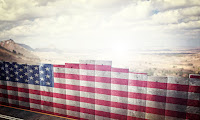Controlling the USA/Mexico border and how people can legally enter the U.S. from Mexico has been discussed since the Nixon administration.
Select History of U.S./Mexico Border Legislation
1969 – President Nixon launched Operation Intercept, calling for the inspection of any or all persons crossing the border by plane, car, or foot. The dispatching of thousands of agents worked. For the first time in history, illegal immigration via car was virtually shut down. Mexico's Foreign Affairs Secretary, Antonio Carillo Flores, complained bitterly about this legislation.
1980′s – Intermittently, border officials question people crossing the border by foot and cars. Heading south to enjoy the Mexican beaches with only a driver's license was a luxury that millions of U.S. citizens enjoyed.
1993 – President Bill Clinton called for constructing a "Border Wall" spanning 13 miles separating San Diego, CA and Tijuana, MX. At $39M, this wall was to reduce the number of arrests for illegal entry from 100,000 to 5,000 per day for those 13 miles. Unlawful entry was found using other paths.
1996 – President Clinton signed The Illegal Immigration Reform and Responsibility Act. This act increased the fines for illegal entry, increased the number of law enforcement agents at the border, and funded more fence construction. Unauthorized access shifted from the previously used crossings to private land. Landowners began to fence their property to keep people from entering the U.S. via their land.
2006 – President Bush signed The Secure Fences Act. This legislation promised 700 miles of a physical barrier and a virtual wall protecting the entire 2000-mile border.
2007 – The Department of Homeland Security (DHS) requests $12B in additional funding because the rugged terrain at the U.S./Mexico border makes constructing the previously agreed upon barrier, a fence or wall, impossible.
2008 – The U.S. announced a mistake during construction, placing the barricade between 1 and 6 feet inside Mexican territory; therefore, we must relocate this part of the barrier immediately. Attempting to complete the barrier project within the year, Congress approved The Department of Homeland Security's circumvention of 30 years of environmental laws.
2010 – The New York Times reports: since 2006, officials found 51 unauthorized tunnels running under the border walls in Nogales, AZ, and Nogales, Sonora, MX. These tunnels served as a tool for the trafficking of drugs, not illegal entry.
2011 – DHS finishes 649 miles of barrier comprised of 350 miles of fencing to prohibit foot traffic ($6.5 million/mile) and 299 miles of vehicle barriers ($1.7M/mile). However, the $1B spent on a "virtual wall" only protects 53 miles of coverage in Arizona. DHS urged President Obama to cut the funding for the costly "virtual wall."

2017 – President Donald Trump renews his campaign promise to build "a great, great wall" to secure the remaining 2,000 miles of the border. Executive orders increase the number of border patrol agents and Immigration & Customs Enforcement by 5,000 and 10,000, respectively.
Current Status and Effectiveness of The Wall
First and foremost, a barrier, slightly longer than 600 miles, exists between the U.S. and Mexico.
The current wall has been effective. The border wall/fence in San Diego has worked quite well. Before it was in place, in the early '90s, approximately 600K people attempted to enter the country illegally. After the barrier was constructed along with increased Border Patrols, that number decreased by 93.5% to 39,000 in 2015.
Also, in 2006, more than 122K people entered illegally in El Paso. In 2017, illegal crossings near El Paso dropped almost 75% to 25K after constructing a border wall.
Unfortunately, the current border is not entirely secure; what we have in place does not stop
caravans of people from finding their way across our border illegally.
Walls Exist Throughout The World
Since World War II, 70 nations constructed border walls. Interestingly, 55 of those 70 walls were built after the Berlin Wall fell.
Some examples are:
- India-Bangladesh;
- Israel West Bank;
- Northern Ireland;
- Finland-Russia;
- France at Calais;
- Morocco-Western Sahara;
- Saudi Arabia-Iraq;
- Baghdad to separate Shiite and Sunni populations;
- Botswana-Zimbabwe;
- South Africa-Mozambique; and,
- Egypt-Gaza.
Three Excellent Reasons To Build The Wall
- The border wall will save lives by creating a deterrent and minimizing the "pull factor." A minor or a family will be less likely to make the dangerous journey (many die on this journey, and somewhere near 80% of the women are raped along the way) from Central America to the U.S. border only to face a 30' barrier or Border Patrol. Additionally, when legitimate asylum seekers cross the border illegally, they are subject to arrest. The wall would "guide" them to seek entry through the established ports of entry and prevent them from being arrested and separated from their families.
- Although a wall is not a perfect solution to block illegal entry, a physical barrier would slow illegal crossings down. Additionally, there are almost 21 million acres of federally protected land along the southern border. Smugglers and traffickers drive all-terrain motor vehicles across this federally protected land, causing substantial damage to the environment.
- The wall would protect the property of legal U.S. citizens. Two Mexican border cities are among the most dangerous cities in the world, and the cartel members often cross over illegally to pillage the neighboring U.S. cities. They intend to steal what they want and take the items and vehicles back to Mexico.
Construction Cost Is NOT Problematic
According to the opponents, the cost to build "Trump's Wall" is estimated at $77,000M ($77B) to construct and $750M annually to maintain the wall. The opponents agree that the annual cost of illegal aliens is $43,000M ($43B)
Using these costs, the construction of the wall would increase the costs spent on illegals by $34,000M ($34B). However, once the wall is completed, the federal savings would be approximately $33,500M ($33.5B).
Undoubtedly, the overall cost of the wall is substantially less than the amount spent on illegals.
So how about it? Let's build the wall! It is best for all.
















